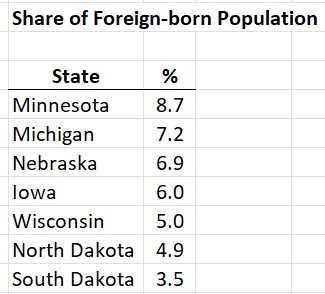Foreign-born population surges in Minnesota
My colleague John Phelan has been writing about the latest U.S. Census data, showing the continued net exodus from Minnesota to other states. Since the last national census (April 1, 2020) through July 1, 2023, Minnesota has lost a net 46,000 people to other states.
Partially offsetting this amount was net international immigration, which totaled 35,000 people over the same period. Natural increase (births minus deaths) allowed Minnesota to overcome the loss to domestic migration and post a modest overall increase in population of 31,000 people over those 3 and 1/4 years. But for international immigration into Minnesota, the state would be losing population.
I’ve written before about how the America now hosts a greater share (over 15 percent) of foreign-born residents than at any point in its long history. California leads among states, with more than a quarter of its population born abroad. Minnesota has a much smaller percentage, but leads among states in our region:

Of course, all of these immigration statistics are obsolete before they are even published, with more than 10,000 illegal immigrants crossing the southern border, every day. And it’s not clear how good of a job Federal authorities are doing in documenting the undocumented (illegal) immigrants entering America.
Minnesota may not rank as one of the most popular destinations for current immigrants. They appear to favor New York, Chicago, and Denver among other big cities. But Minnesota appears to be a significant secondary destination, taking castoff Ecuadorian migrants forwarded from New York, for example.
The best estimates available indicate that Minnesota has more than 500,000 foreign-born residents. If they were a separate city, foreign-born residents would be, by far, the state’s largest with Minneapolis boasting only 425,000 inhabitants.
In addition to the half-million foreign-born residents, Minnesota includes a large number of “second-generation” immigrants, children born in the United States to foreign-born parents. Historic ratios suggest that the state includes hundreds of thousands of additional residents that fall into that category.
Still, current immigrant levels are far below those seen during the state’s frontier days. The previous immigrant peak dates from 1900 to 1910. Back then, immigration was dominated by newcomers from Germany, Norway, and Sweden.
As shown in this graph, foreign immigration to Minnesota all but stopped between the years 1970 to 1990. Since then, immigration has spiked, now dominated by newcomers from Mexico and India, along with Somali and Hmong populations, the latter of whom arrive from multiple nations. As of 2021, the number of Mexican immigrants in Minnesota stood at about 55,000, with Somalians in second place at 40,000.
By continent, Asia provides the most immigrants to Minnesota at about 180,000, with Africa providing about 140,000. Migrants from Latin America total about 110,000. Europe contributes 44,000 with the rest from elsewhere around the globe. Of the 44,000 from Europe, only 8,000 hail from Northern Europe, a complete reversal from the state’s early history.
Whether these changes in immigration levels and origins are positive or negative developments depends on one’s viewpoint. But these changes are significant and present public policy challenges that must be met in the next few years.